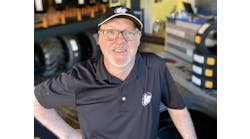This MTD exclusive was provided by Michael McGregor, a partner at Focus Investment Banking LLC (focusbankers.com/ automotive/tire-and-service) and author of MTD's monthly Mergers and Acquisitions column.
A Supreme Court Justice once observed that “the true symbol of the United States is not the bald eagle. It is the pendulum. And when the pendulum swings too far in one direction, it will go back.” This pendulum swing may be happening right now with regards to corporate profits and employee wages.
According to the Federal Reserve Bank of St. Louis, corporate profits as a percentage of gross domestic product (GDP) more than tripled from a low of 3.7% in 1985 to a high of 11.5% in 2021.
At the same time, employee compensation as a percent of GDP declined by 20% over much of this same period, from the high point in 1970 to the low point of 2015.
This is partially what is behind the “great resignation” we observed during COVID-19. We’ve seen decades of unparalleled profits in corporate America, while workers’ wages have remained stagnant. Some workers feel they have been left out and their wants have been ignored.
The pendulum has now swung back in their direction. Many are looking to “work to live” rather than “live to work.” They want to be valued for the work they do and they demand higher pay.
Why else would 4.5 million people quit their jobs last November - the highest resignation rate per month ever, according to the Bureau of Labor Statistics? Workers voted with their feet.
While there are many ways to attract and retain employees, I’m going to focus on just one - having a mission or purpose they can buy into, other than just making a buck.
A quick check of some leading automotive chains’ websites tells me that a lot of businesses are looking inward when presenting themselves to the public. Statements like “we are after complete customer satisfaction,” “we will not be undersold,” “safety is our priority” and “we offer the highest quality” are what I mostly find.
A few have vision statements, but the purpose of those is to explain why customers should shop at their stores.
An effective mission statement explains your organization’s reason for existing. It’s a simple, short explanation of your company’s purpose and intent. This mission statement can support a company’s vision of being the best or being the lowest-priced or whatever that vision is.
But a concise statement must give your employees, customers and stakeholders an idea of what you are all about. And it should give your associates a greater sense of identity.
In my previous career, my mission was “to keep people driving by providing peace of mind with predictable, affordable, high-quality car care.” The “keeping people driving part” was intended as the general purpose “feel good” - implying we help move people and society forward. The other parts related to our subscription-based model that was intended to re-engineer the auto service business.
Customers and employees bought into our mission. This was reflected in everything we did in our stores and even in our community involvement.
Every month, each of our stores took in a donated or abandoned car and fixed it up at no cost for needy people through Goodwill’s Car Donation Program. Our employees felt really good about this and it reinforced our mission to improve the auto repair business for everyone.
When I exited that business, I chose to reinvent myself as an investment banker. I was no longer on the grand mission of re-engineering the car care business and was instead “just doing deals.”
My son, Neil, who was maybe eight years old at the time, told me that what I was now doing was just as important as what I did before because I was helping people. So that’s my mission. I help people.
If a tire dealer wants to pick my brain about what their options are, I’ll spend some time educating them - even though I can’t represent them if they are too small.
If a tire wholesaler is facing liquidation because their main vendors pulled their lines, I‘ll see what I can do to engineer a quick exit - even if it’s too late.
If a multi-location tire dealer is breaking even, I’ll look at their books and give them ways to improve their performance.
I speak at industry conferences to help educate tire dealers. I write this column to hopefully make you more aware of the private capital markets - and your options. All of that is without getting paid.
Now don’t get me wrong. I make a great living as an investment banker helping people in the automotive business. But it’s my mission that drives profit and not the other way around. I urge you to find your mission. It will benefit you and your business. And it will benefit your employees — giving them a higher purpose to rally around.




